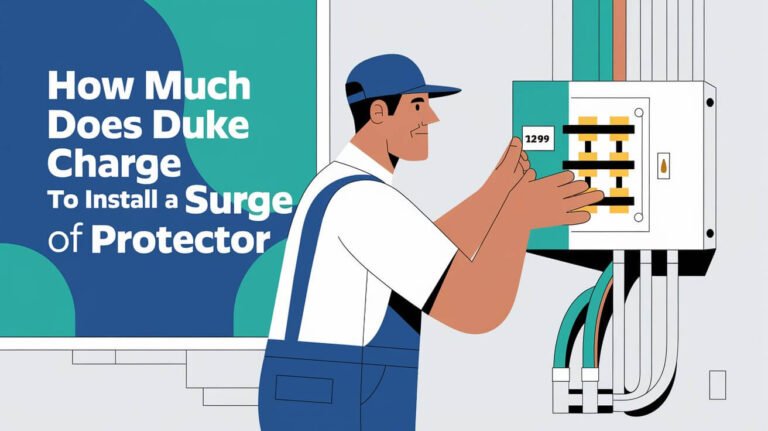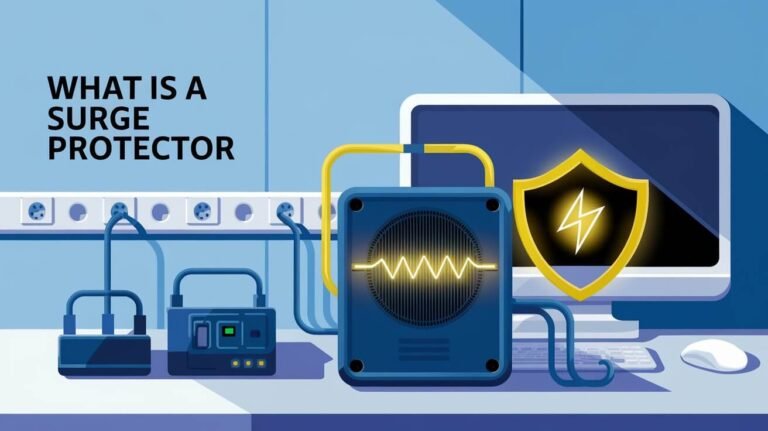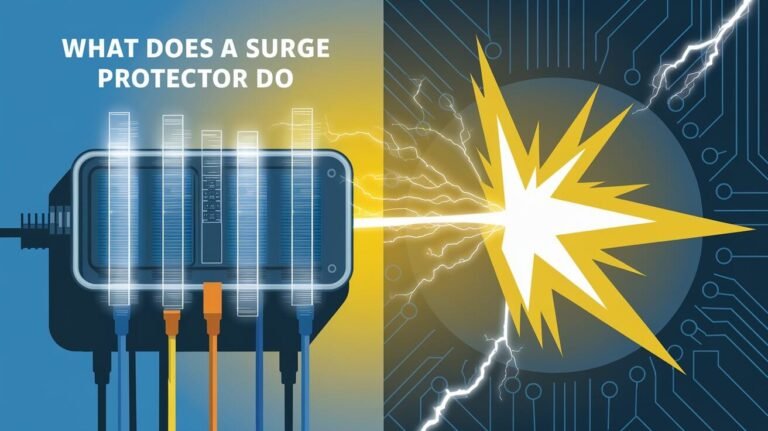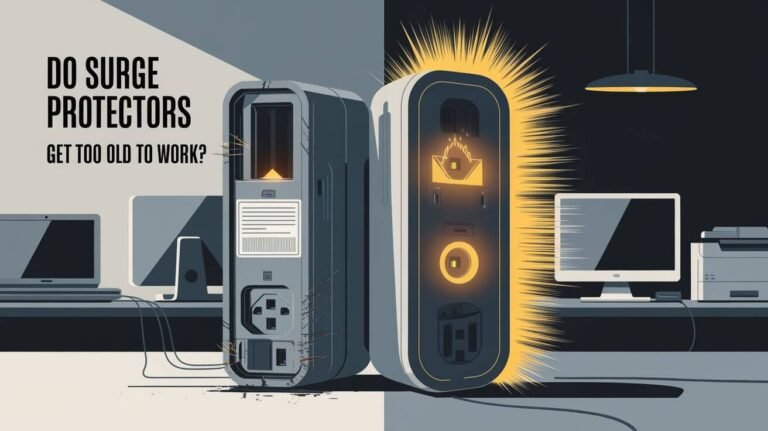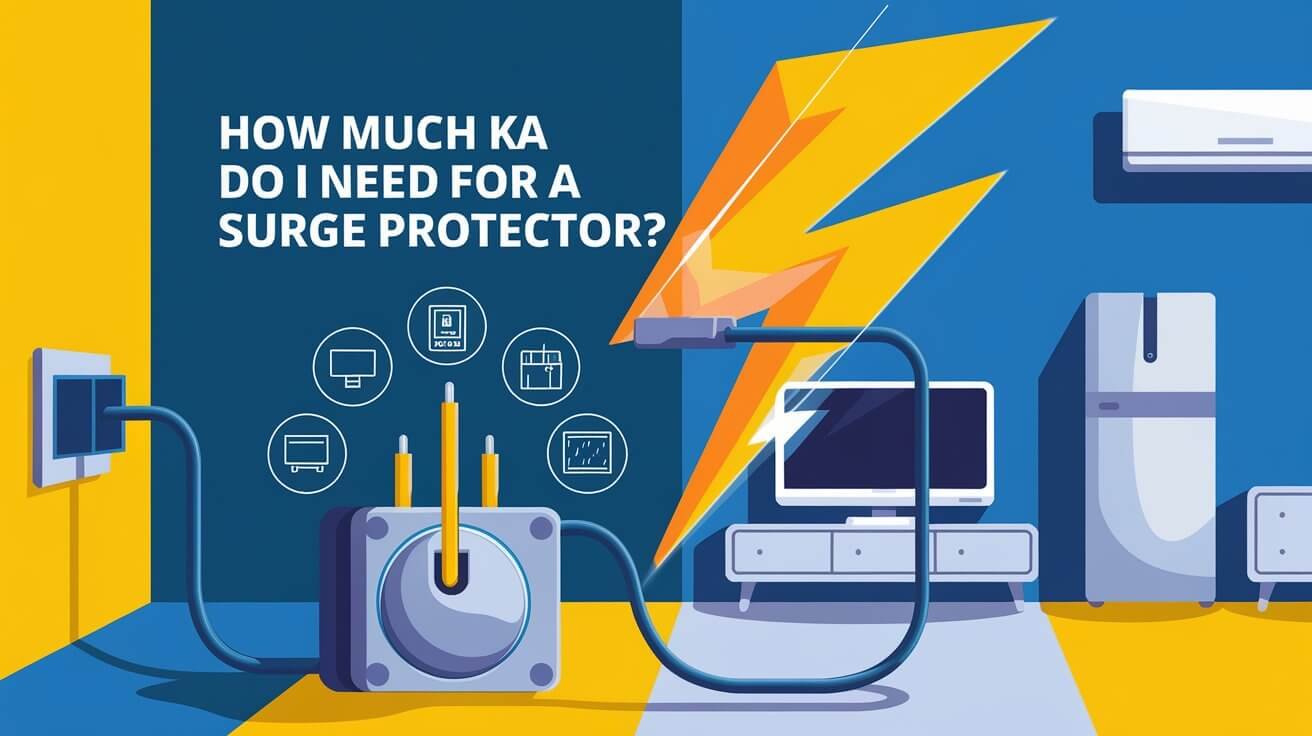
Surge protective devices (SPDs) are key in stopping voltage spikes that harm electrical gear. This makes surge protector ratings very important for keeping things safe. When protecting your home or business, picking the right surge protector is vital to avoid damage from power surges.
There are different surge protectors, like Type 1 for service entrance and Type 2 for the main entrance panel. Choosing the right one can be tough.
To get the best electrical protection, think about the location’s needs, as the UL1449 standard says. For example, homes with 120-volt service need a surge protector rated up to 80kA. Homes with subpanels need extra protection. Knowing about surge protector ratings and electrical protection helps you make smart choices. This way, you can protect your valuable equipment and avoid expensive damage.
Role of KA Ratings in Surge Protection
Kilo-Ampere ratings are key to a surge protector’s success. They measure in kilo-Ampere (kA) and are often not well understood. Knowing about kilo-Ampere ratings helps ensure your surge protector can handle electrical surges well.
A surge protector’s strength against electrical surges depends on its kilo-Ampere ratings and surge current capacity. The higher the kilo-Ampere rating, the better it protects against electrical surges. For example, a surge protector with a higher kilo-Ampere rating can handle bigger power surges. This makes it perfect for places that often have power outages or electrical storms.
Basic Definition of KA Ratings
Kilo-Ampere ratings measure in thousands of amperes (kA). They show the maximum electrical current a surge protector can handle safely. This rating is key to knowing how well a surge protector protects against power surges.
Why KA Ratings Matter
Kilo-Ampere ratings are important because they help you pick the right surge protector for your gear. A surge protector with the right kilo-Ampere rating can stop damage from power surges. This keeps your devices working and safe to use.
Common KA Rating Ranges
Surge protectors come in various kilo-Ampere rating ranges. Here are some common ones:
- 100 kA for branch panels
- 200 kA for distribution panels
- 300 kA for service panels
These ranges help figure out the protection level needed for different uses. This includes homes, businesses, or industrial settings.
| Kilo-Ampere Rating | Application |
|---|---|
| 100 kA | Branch panels |
| 200 kA | Distribution panels |
| 300 kA | Service panels |
Surge Protector Components and Their Functions
Surge protectors have different parts that work together to protect against voltage spikes. These parts include metal oxide varistors, silicon avalanche diodes, or gas discharge tubes. Each part is key in safeguarding electrical devices from power surges and spikes.
The surge ratings for Surge Protective Devices (SPDs) depend on several factors. These include the panel’s location in the facility. It’s recommended to have surge current ratings of 300 kA/phase for Service Entrance. For Distribution Panels, 200 kA/phase or 100 kA/phase is suggested. For Branch Panels, 100 kA/phase or 50 kA/phase is recommended. Important considerations for SPD components and voltage protection include:
- Proper surge suppression requires more than a single SPD at the service entrance
- Cascaded SPDs are recommended for superior suppression
- Over-sizing an SPD for its application is not harmful, but under-sizing can lead to premature failure
Understanding the different SPD components and their roles helps in choosing the right surge protectors. This ensures optimal voltage protection and prevents damage from power surges.
| SPD Type | Protection Rating |
|---|---|
| Square D HEPD series | 25kA, 50kA, 80kA |
| Plug-on neutral SPDs | 50kA |
How Much Ka Do I Need For Surge Protector: Complete Rating Guide
To find the right Ka rating for your surge protector, think about your setting’s needs. Whether it’s a home, business, or industrial area, the Ka rating changes. It depends on the building standards and how much protection you need.
Residential KA Requirements
For homes, the Ka rating is usually lower. A common guideline is the “3-2-1 Rule of Thumb”: 300 kA for main entrances, 200 kA for distribution panels, and 100 kA for branch panels. This helps keep your home safe from power surges and spikes.
Commercial Building Standards
Commercial buildings need stronger surge protection because of the higher risk of power surges. The Ka rating for these places is often higher, ranging from 200 kA to 400 kA. This depends on the building standards and the equipment being protected.
Industrial Application Needs
Industrial settings need the most surge protection because of the expensive and sensitive equipment. The Ka rating for these areas can go from 400 kA to 600 kA or more. It’s important to talk to a professional to find the right Ka rating for your industrial needs.
| Setting | Typical Ka Rating |
|---|---|
| Residential | 100-300 kA |
| Commercial | 200-400 kA |
| Industrial | 400-600 kA or more |
Calculating Your Required KA Protection Level
To find the right surge protection for your electrical system, you need to assess it well. Look at where your facility is and what equipment it has. The size of your panel isn’t as important as the location of your equipment.
When calculating surge protection, think about the risks to your system. Consider lightning strikes, power grid issues, and internal surges. This helps you figure out how much protection you need to keep your system safe and reliable.
Important things to think about include: * What equipment you have and where it is * The risks to your electrical system * How much surge protection you need for safety * The need for regular checks and maintenance to avoid surges and keep your equipment working well.
| Category | Location | Required Surge Protection |
|---|---|---|
| Category C | Service Entrances | 10kV, 10kA surges |
| Category B | Downstream more than 30 feet from Category C | 6kV, 3kA surges |
| Category A | Further downstream more than 60 feet from Category C | 6kV, 0.5kA surges |
Following these steps and doing a detailed assessment, you can make sure your surge protection is right. This will help protect your electrical system from power surges and other dangers.
Safety Standards and Certification Requirements
Electrical safety standards are key for surge protectors. They make sure these devices can guard your gear from power surges. The UL1449 standard is a big deal here. It outlines what Surge Protective Devices (SPDs) must do to protect your stuff.
Other important standards and certifications also matter. IEEE guidelines and the National Electrical Code help ensure surge protectors are safe and work well. These rules help make sure surge protectors meet certain safety and performance levels. This gives you confidence when picking a surge protector.
UL Standards for Surge Protection
The UL1449 standard is vital for electrical safety. It makes sure surge protectors can really protect your equipment. This standard tells SPDs what kinds of surges they must handle and how well they must protect.
IEEE Guidelines
IEEE guidelines offer more advice on picking and setting up surge protectors. They help make sure these devices are used right and safely. These guidelines help people understand why electrical safety standards and surge protector certification are so important.
| Standard | Description |
|---|---|
| UL1449 | Defines the requirements for Surge Protective Devices (SPDs) |
| IEEE guidelines | Provides guidance on the selection and installation of surge protectors |
| National Electrical Code requirements | Ensures that surge protectors meet certain performance and safety criteria |
Types of Electrical Equipment and Their KA Needs
Protecting electrical equipment from power surges is key. Each type needs different surge protection levels. This depends on how sensitive it is and how often it faces surges. It’s vital to match the surge protection to the device for safety and longevity.
Devices like computers, TVs, and fridges need surge protection. They can be saved with surge protectors that have different KA ratings. For instance, a Type 2 Surge Protection Device (SPD) is needed for AC feeds with Up 20 kA.
Here are some important points for protecting electrical equipment:
- Category A loads, more than 60 feet from the service entrance, can be exposed to 6 kV and 0.5 kA surge currents.
- Category B loads, between 30 and 60 feet from the service entrance, may face 6 kV and 3 kA.
- Category C loads, less than 30 feet from the service entrance, might experience 20 kV and 10 kA.
Testing ground resistance and ensuring proper grounding are also key. Knowing what surge protection each device needs helps protect them. This ensures their safety and extends their life.
| Equipment Type | Recommended KA Rating | Surge Protection Device |
|---|---|---|
| Computers | 10-20 kA | Type 2 SPD |
| Televisions | 5-10 kA | Type 1 SPD |
| Refrigerators | 20-30 kA | Type 2 SPD |
Common Surge Scenarios and Required Protection
Electrical surges can happen for many reasons. These include lightning strikes, power grid changes, and internal surges. Knowing why surges happen helps us figure out what protection we need.
Big surges often hit at the main power entrance. This shows we need strong protection there.
Some common surge scenarios include:
- Lightning strikes, which can generate surge currents of tens of thousands of amperes
- Power grid fluctuations, which can cause transient overvoltages
- Internal surge events, such as switching operations and electrostatic discharges
Lightning Strikes
Lightning strikes are a big reason for surge voltages. They can create currents of tens of thousands of amperes. Devices like those from Phoenix Contact can protect against these surges.
Power Grid Fluctuations
Power grid changes can lead to surge voltages. These voltages can spread to power lines, causing overvoltages. We need to protect against these changes.
Internal Surge Events
Internal events, like switching and static discharges, can also cause surges. Knowing about these helps us find the right protection for our electronics.
Price Considerations for Different KA Ratings
The cost of surge protectors changes with the KA rating and protection level. A higher KA rating means a higher price. But, it’s key to weigh the cost against the protection you need.
Several things can change the surge protector cost. These include the Voltage Protective Rating (VPR), Maximum Continuous Operating Voltage (MCOV), and Maximum Surge Current Capacity. A lower VPR means a higher cost. A higher MCOV and Maximum Surge Current Capacity also raise the price. The brand’s reputation, the electrician’s quality, and the warranty period also play a role.
When looking at surge protector cost and protection level pricing, consider these factors:
- KA rating: A higher KA rating offers more protection but costs more.
- VPR and MCOV: Lower VPR and higher MCOV lead to higher costs.
- Maximum Surge Current Capacity: Higher capacity surge protectors are pricier.
- Warranty period: Longer warranties add to the overall cost.
- Brand reputation: Well-known brands might charge more.
It’s important to find a balance between cost and protection. A surge protector with the right KA rating can give you peace of mind. It also protects your valuable equipment from power surges. Companies like D&F Liquidators offer good prices on electrical materials, including surge protectors, thanks to their bulk purchases.
Installation Requirements Based on KA Rating
Understanding the KA rating is key for surge protector installation. It shows how much protection your electrical system needs. The right installation is vital for the best surge protection.
Where you put the surge protector matters. For example, a service panel needs a higher KA rating than a branch panel. Use 300 kA for service panels, 200 kA for distribution panels, and 100 kA for branch panels.
Professional Installation Guidelines
For complex systems, get a pro to install the surge protector. A skilled electrician will make sure it’s done right. They’ll also integrate it into your electrical system.
DIY Installation Considerations
If your system is simple, you might install it yourself. But, you must follow the right steps. Make sure the surge protector is close enough to the equipment it protects. If it’s more than 10 meters away, use a Type 2 or Type 3 SPD near the load.
Some important DIY tips include:
- Check if the surge protector fits your electrical system
- Read and follow the manufacturer’s installation guide
- Make sure the surge protector is grounded correctly
| KA Rating | Application | Recommended Installation |
|---|---|---|
| 300 kA | Service panels | Professional installation |
| 200 kA | Distribution panels | Professional installation |
| 100 kA | Branch panels | DIY installation (with proper guidelines) |
Following these tips and knowing your system’s needs, you can protect it well. This ensures your electrical system works best and is safe from surges.
Risk Factors and Protection Levels
Understanding the risk factors for surge protection is key. This includes looking at your location, as places like Florida face a lot of lightning. It’s important to assess the risk to choose the right protection level.
Different equipment can handle surges differently. For example, data centers and delicate electronics need extra care. You should think about the cost of damage, downtime, and legal issues when planning protection.
Here are some things to consider:
- Lightning strike history in your area
- Type and sensitivity of equipment being protected
- Local power grid stability
- Surge ratings of available protective devices, such as 100kA or 200kA for 480-volt service
Looking at these factors and doing a risk assessment, you can pick the right protection level. This ensures your equipment is safe from surge currents.
Conclusion
Proper surge protection is key to keeping your electrical and electronic gear safe. We’ve seen how the KA rating matters a lot. It shows how well a surge protector can protect against voltage spikes and lightning strikes.
The National Electrical Code (NEC) now requires surge protection for homes and businesses. This change in 2023 shows how important it is. Keeping up with surge protection trends helps protect your valuable items and keeps your electrical systems working well.
It’s important to check and replace your surge protectors often. This keeps them working right. By following good practices and staying alert, you can protect your place from power surges. This ensures your electrical systems stay reliable for a long time.
Frequently Asked Questions
What is a surge protector and why is it important?
A surge protector is a device that protects electrical equipment from power surges. It’s key to pick the right surge protector to keep your devices safe.
What do KA ratings mean for surge protectors?
KA ratings show how well a surge protector can handle electrical surges. Picking the right KA rating is important for protecting against power spikes.
How do the different KA rating ranges relate to surge protection?
KA ratings range from low (up to 15kA) to high (over 50kA). The right rating depends on your home or business’s electrical needs.
What are the key components of a surge protector and how do they work?
Surge protectors have parts like MOVs and inductors. They work together to block dangerous electrical surges, keeping your devices safe.
How much KA do I need for different residential, commercial, and industrial settings?
The KA rating needed varies by setting. Homes usually need up to 20kA, while businesses and factories might need 30kA or more.
How can I calculate the appropriate KA rating for my electrical system?
There’s no formula, but consider your facility’s size, devices, and local power grid stability. This helps determine your KA rating needs.
What safety standards and certifications should I look for in a surge protector?
Look for surge protectors that meet UL, IEEE, and National Electrical Code standards. These show they’ve been tested and approved for safety.
How do the KA requirements differ for various types of electrical equipment?
Different devices need different surge protection. For example, computers might need up to 50kA, while simple appliances might only need 15kA.
What common surge scenarios require specific KA protection levels?
Scenarios like lightning strikes and power grid issues can cause dangerous surges. The right KA rating protects your equipment from these threats.
How does the KA rating affect the price of a surge protector?
Higher KA ratings mean more protection and higher prices. Finding the right balance between cost and protection is important.
What are the installation requirements for surge protectors with different KA ratings?
Installation needs vary with KA rating and system complexity. Some may be DIY, but others might need a pro for safe setup.
What risk factors should I consider when selecting a KA rating for my surge protector?
Consider your location, power grid stability, and equipment types when choosing a KA rating. These factors affect your surge protector needs.

